有關1.11版本前的後勤系統,請參考本頁面的歷史版本。
在鋼鐵雄心4中,後勤(Logistics)是指將戰鬥人員(增援)和裝備送到需要的地方去,以此來支持作戰部隊,同時確保作戰單位所在地的補給水平足夠他們有效率的行動。其中最重要、最複雜的元素就是在1.11版本(「巴巴羅薩」補丁)大改的補給系統。
補給
補給本身並不是生產出來的,省份的補給水平代表了對作戰部隊的「支持限度」(可以把它看成是一種柔和的單位堆疊限制)。每一個陸戰單位自身也有一個內部的補給狀態,和其所在省份的補給水平相獨立,但兩者之間也有關連。
一個省份的可用補給來源於三個不同的部分:「補給中心補給(Hub Supply)」、「空投補給(Aerial Supply)」和「地區補給(State Supply)」。補給中心的補給是通過補給網絡從一個國家的首都運輸到此國前線作戰部隊的。而補給網絡則由補給中心、港口、鐵路和運輸航線構成。空投補給是由執行空投任務的運輸機提供的,僅對其空投的空域有效。地區補給則是指每個地區都有的一個固定的補給量,所有作戰單位都可以從所在地區中獲得補給(如果是一個還沒有被某一方所完全占領的地區,該地區的補給則由占領的數方部隊共享)。
- 值得注意的是,即使一個作戰單位能從補給中心獲得所需的全部補給,他依然會從所在地區的補給當中抽取一部分。實際上,他們會優先使用地區補給,其次使用補給中心的補給,最後才使用空投的補給。
只要作戰單位所需的補給總量小於所在省份能提供的補給量,那麼這些作戰單位就能完全補給。相反,則這些作戰單位將承受懲罰。下面將會詳細介紹。
補給地圖
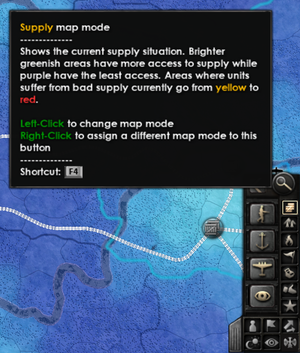
The two crates in the map mode selection area in the bottom-right of the screen indicate the supply map mode.
補給情況在遊戲中主要通過供應地圖模式顯示。在默認設置下,可以通過按下"F4"鍵或在屏幕右下角選擇補給地圖模式圖標來訪問此模式。
補給地圖通過不同的着色來展示每個省份的供應狀況。這些顏色漸變使得同時查看數百個省份的補給情況時也能一目了然。
- 亮(淺)藍色:有大量可用的補給
- 深藍色:有少量可用的補給
- 紫色:有少量或沒有可用的補給,但該省份的部隊沒有受到低補給的影響。
- 黃色:該省份的部隊補給供應部分不足,但仍有足夠的補給讓部隊不至於受到嚴重的debuff。
- 亮紅色:該省份的部隊補給供應嚴重不足,它們正遭受重大的補給相關懲罰。
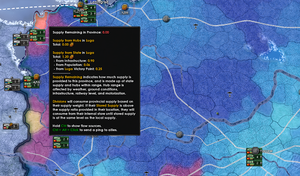
在莫斯科周圍,供應充足的省份是亮藍色的,而在更遠的地方,它們變成了深藍色。一些邊境省份的補給供應不足(比如選中的這個省份),該省沒有剩餘的供應,無法完全供應駐紮在那裡的部隊,它們用明亮的橙色表示。紫色省份的供應量很低或沒有可用的供應,但沒有部隊駐紮。
補給地圖模式中的工具提示非常有用,將鼠標懸停在不同物品上會顯示不同的信息:
單位: 單位補給消耗,以及補給的來源。
補給中心: 補給中心需要的補給量,並突出顯示連接首都的鐵路。按住 Shift 鍵會顯示補給中心的範圍(當時--範圍會隨天氣變化)。
港口: 補給中心所需的補給量,並顯示可能從港口提取樞紐(但非國家)補給的任何船隻的路徑。按住 Shift 鍵會顯示補給中心的範圍(當時的範圍--範圍會隨天氣變化而變化)。
省: 某省的總供應量和可用供應量。按住 CTRL 鍵還會顯示樞紐補給的來源明細。
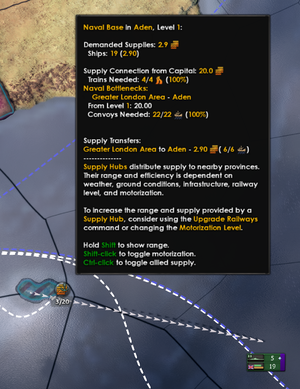
Hovering over the port on the island to the South-East of the Arabian Peninsula also brings up arrows to ships supplied by that port, as well as a tooltip containing much useful information.
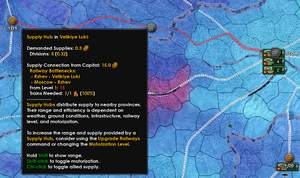
Bringing up the tooltip for the supply hub of Velikiye Luki highlights in red the rail connection to the capital, while the tooltip provides a range of information on the nature of the hub.
後勤
補給中心
中心補給是給補給中心或者港口提供補給 (激活的補給中心, 港口也一樣),我們關注中心補給時有3個要素需要注意:
- 一個補給中心的可消耗的總容量。
- 補給中心的範圍,和一個特定省份補給中心補給量。
- 一個特定省份收到的補給來源於所有範圍中的補給中心。
大多數情況下,在寫文本時,最常見的供應問題是基於特定省份的不充足的供應,不是總供應量不足。
總補給中心補給能力
補給中心/港口的總吞吐量基於與首都相連不同等級的鐵路相連的補給中心/港口,首都之間,港口之間的鐵路水平(包括車隊的到達和離開)
與首都相連的一個補給中心的一級鐵路為該補給中心提供了一個基本15的供應吞吐量,每個增加等級鐵路建築吞吐量增加5,直到最大值35。等級1的港口與其他等級的港口供應,收到的港口基礎是8補給。每個增加的港口等級建築會增加3的補給吞吐量,直到最大35。注意:如果護送車隊供應中的港口被襲擊,供應提供量會被減少直到鐵路被恢復其容量,此外,供應生產量的上限基於最小的鐵路或港口供應量在任何一個相連的店(所以,舉個例子,如果有3個鐵軌,2個等級2,1個等級1,相連被認為是一個1級相連同時有15的補給,直到升級到等級2相連會有20的補給量,等級1的鐵路會需要升級到等級2)(另一個例如,如果有3個鐵路相連到等級6的港口到一個等級5的港口,鏈接被認為是一個等級5的相連並提供20的供應)。河流可用作一級鐵路連接。
每級港口提供的補給量
| 1
|
2
|
3
|
4
|
5
|
6
|
7
|
8
|
9
|
10
|
| 8
|
11
|
14
|
17
|
20
|
23
|
26
|
29
|
32
|
35
|
每級鐵路補給量
一個例外是這個首都的補給中心,它的吞吐量基礎是5,然後一定量的民用工廠和軍用工廠和造船所。
補給中心供應範圍
補給中心供應給每個身份基於許多因素,最重要的是省份之間提供存在的補給中心,這個存在的修正主要是鐵路連接的等級去供應來自首都的補給中心,基礎設施(指所有可以建築)的水平。
地形,和 天氣.

看看屏幕截圖「來自補給中心」價值,隨着距離的增加,來自補給中心的供應價值減少。注意,地區彈出的提示是該省份地區所在的地區,不是省份連接的補給中心提供的來源。(最右邊的提示,仍然寫着供應來自Akhtubinsk)。
提升補給範圍
除了空中補給以外,給一個省份提升補給水平是在整個遊戲的過程中,幾乎總會完全的由於改善了補給中心的供應量。下列4個方法可以提升。:
- 增加補給中心的機動化水平或是軍隊的(軍隊的補給機械化指令)
- 增加鐵路鏈接到補給中心的等級。
- 增加地區的基礎設施等級。
- 建造一個新的補給中心
注意,前三種方法(機械化,增加鐵路連接等級和增加基建等級)總是可以疊加-所以一個摩托化補給中心是一個地區有1級基礎建設和1級的鐵路相連將會有最小的供應範圍,當一個完全的摩托化補給中心和5級基建和5級鐵路相連,會有最大的補給範圍。
非常重要的一點是關心補給中心供應,分散開來可以顯著的增加,特別是來自更多的補給中心和港口,或首都-------增加補給範圍,分別建設的改變也許相對較小,經常投入大量的投資可以增加範圍也許會足夠推進他從中心到下一個省份。
摩托化
默認情況下,每個補給中心設置成非摩托化,圖片是一個馬。這是個可以提升到2個不同的摩托車,單擊可以讓他變成運轉圖標(看舉例的圖片)。一旦一個中心摩托化後,圖標會變成1個或者2個小卡車(基于于摩托化水平),一個綠色或者更多的卡車表示,這個補給中心直接描述的摩托化,當灰色卡車表示,它已經變成摩托化並支援了附近的軍隊---更多的在下面。注意補給中心變成卡車賦值摩托化,無論是否直接的經由補給中心或選擇摩托化,選項,都不會消耗燃料或人力。
依賴於摩托化的等級,每個補給中心需要0,40,或80的卡車(圖片為,馬,1輛車,2輛車)
這些卡車損耗,在惡劣的 地形和天氣下增加,它們也會受到來自敵人飛機的後勤打擊任務

Observe the changing icons as the level of motorisation of the Odessa supply hub (port) is increased. As per the far-right image, as long as a hub is motorized, it will have an icon of one or two trucks to indicate this (the number of trucks indicating the level of motorization).
其他方式達到補給中心摩托化,在軍隊等級去分配它。這將自動切換在軍隊獲取補給品的範圍內的樞紐上為軍隊設置的機動化水平。這一優點是降低了樞紐機動化水平的微觀管理,但它可能導致對軍隊的需求波動,因為軍隊範圍內的樞紐數量隨着時間的推移而變化。請查看下面的三個截圖和說明
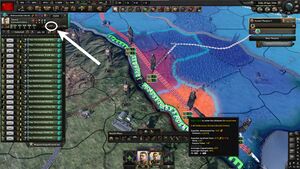
In this example, the troops at Tiraspol, to the north-west of Odessa, aren’t fully supplied. While the level of supply isn’t critical, one way to improve the level of supply would be to increase the level of motorization of the army (is currently set to 「not motorized」, as indicated by the 「horse」 highlighted by a white ellipse and arrow in this screenshot).
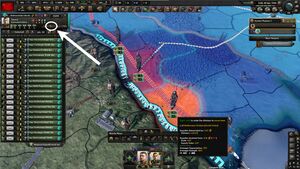
The army has now selected the first level of motorization, again highlighted by a white ellipse and arrow), and the supply situation for the troops at Tiraspol has improved considerably. Also note the small grey truck that is now part of the icon for the Odessa supply hub.
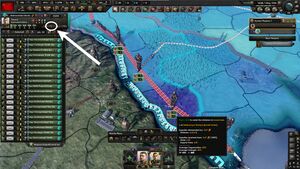
The army has now selected the second level of motorization, again highlighted by a white ellipse and arrow), and troops at Tiraspol are now fully supplied. Also note that the grey 「truck」 icon that is part of the Odessa supply hub icon now has two trucks in it.
請注意,只有在有足夠的卡車時,才會得到機動化的全部好處。如果分配給支持樞紐的卡車比可用的要多,那麼收益將會減少,與卡車的短缺成比例。
File:Supply-015.jpg While Rokossovky’s army has full motorization toggled, because of the shortage of trucks (note the tooltip), the troops at Tiraspol are not fully supplied.
提高鐵路等級
在摩托化之後,增加鐵路鏈接等級是下一個最有力和常見中最快的(但它取決於如何離你的首都和鐵路供應補給中心有多遠)
File:Supply-016.jpg To find out the level of the rail connection between a hub and the capital, hover over the hub in the supply mapmode, and see what the tooltip says about the bottleneck. In this case, Akhtubinsk is limited by its railway connection only being level 2, for the entire path from Moscow.
每個鐵路花費170CIC,+130CIC給每個存在的鐵路等級(最大到等級5),所以,它相對最快和最便宜去放置一個等級1的鐵路,訂單一個長的等級5的鐵路是一系列的企業建設。舉例說,詳見下表,總CIC去建築鐵路來自沒有到達5,是2.150CIC每個省份(170+300+430+560+690),修正後的任何建設獎勵和基礎建設速度影響。
鐵路花費 (CIC) 每級, 每個省份
| 鐵路等級
|
1
|
2
|
3
|
4
|
5
|
| CIC 花費
|
300
|
430
|
560
|
690
|
820
|
實際上鐵路建築可以有很多種方式:
- 選擇補給中心,然後點擊中間按鈕(頂部)三個顯示圖標中間,每次點擊會提升其他鐵路等級到連接到首都的每個省份鐵路的連接情況,3次補給連接可以讓2級的鐵路鋪設命令到最大等級
- 開放生存可以讓生產界面,和選擇「鐵路」按鈕,然後點擊白色按鈕中的一個,在黑色圈一個由2個補給中心鐵路連接-這會放置鐵路建設命令去增加鐵路等級在2個補給站中間,每次增加會放置鐵路增進等級
File:Supply-017B.jpg Here the supply hub button has been pressed, bringing up the three icons – the one in the middle, highlighted by the arrow, will put in construction orders to upgrade the rail connection to the capital.
File:Supply-018.jpg Here, the 「upgrade rail connection to capital」 has been pressed for Akhtubinsk – see the construction orders in the construction build queue, as well as the 「under construction」 icon on the stretches of railway being upgraded in the supply map mode.
File:Supply-020.jpg The 「2」 between Lipetsk and Tambov highlighted here, indicates that the level of rail connection between the two supply hubs is level 2. Click on this two with the 「rail」 tool in the production interface selected, and construction orders will be placed to increase the level of the rail connection between the two hubs.
每增加一級的鐵路會增加補給中心一定大小的總補給供應,它意味着補給流動從補給中心外流也會增加。在一些情況下也意味着省份可以在沒有貿易中心的情況下會收到一些補給中心的補給,如上所述,增加「供應流動下降」更遠來自補給中心意味着補給擴張範圍可能會受到限制。
File:Supply-019.jpg This series of screengrabs shows the impact on a province on the Soviet border with Finland of incrementally increasing the level of rail connection to the hub from 1 (far-left) through to five (far right) – note the weather is clear, and the hub is not motorized.
請記住,鐵路對戰略重新部署也很有用,而且鐵路水平越高,部隊的戰略重新部署速度就會越快。
建造新的補給中心
File:Supply-021.jpg Here, Japan selects a supply hub for construction, which they then place it in a province where it will have a useful distribution. Bear in mind supply hub range is by province, not by area, so all else being equal supply will flow from a hub through two large provinces just as well as it will through two small ones.
如果它看起來是沒有成本收益,可能,需要建設一個新的補給中心來補給。在海岸上,港口作為供應樞紐,而且要便宜得多(海軍基地第一級為5000CIC,後續每級的成本再增加1000CIC)。然而,內陸地區需要使用供應中心,這需要20000個CIC(由任何建設速度和基礎設施建設獎勵修改)。
港口和供應中心都是使用建設頁面的,如下圖的截圖所示。
港口和補給中心可以在盟國和屬國的領土上建造。
如果它可以通過車隊、其他港口和鐵路追蹤到首都,那麼一個港口將由海上供應,而不需要鐵路連接。
File:Supply-022.jpg Here, Japan selects 「railways」 in the construction interface, and the clicks on the province to the south-west of where the new supply hub is building, and then clicks on the province containing the supply hub that’s being built.
補給中心也會要求連接到首都,通過鐵路或河流進行追蹤。通過河流的連接是即時的,可以考慮是否去造一個新的補給中心(與包含供應中心的省份接壤)連接到首都或鏈接到另一個補給中心,或港口所在的省份
To connect a new supply hub with a rail connection, open the construction interface and select the 「railways」 option, and then click on a province with a railway that is connected to the capital, and then click on the province with the new supply hub. The level of the railway constructed will be the same as that of the level of the railway in the province that it’s extending from, but this can be manually adjusted down or up levels (as long as the railway hasn’t been built yet) using either the construction list (the +/- buttons on the railway in the list) or on the supply map (left-click on small number (underneath the crossed hammers) on the railways under construction to increase the level, and right-click to decrease the level).
鐵路可以在任何時候在控制、盟友或屬國領土內建造,並且不需要等待一個補給中心完成(甚至啟動)。
File:Supply-023.jpg Improving the level of infrastructure in the state of Arkhangelsk improves the level of hub supply provided at the airbase to the south of the hub. Note that the overall supply in the province increases by significantly more, because infrastructure has both a hub supply range and a state supply effect – more on state supply below.
提高基礎設施等級
高等級的基礎建設也允許補給從補給中心到更遠,該流動補給的供應會直線下降,(對於基於5級基礎設施而言最大減少至0.3),注意那個基礎設施的等級問題是地區鏈接省份來自流動供應。所以,舉個例子,如果這有2個地區,一個地區有5的基礎設施和一個邊境省份有一個等級1基礎設施的地區。會有流動供應,就像5的基礎設施流動到1級的基礎設施。
與其他擴大供應中心範圍的方式一樣,隨着距離中心(按省)的增加,供應減少的增加意味着任何增加可能只在邊緣(即可能增加一個省的範圍)。
請注意,每個基礎設施的花費是6000CIC--所以諸如等級4的基礎設施在一個省份的花費會超過建設一個新的補給中心
火車
為了充分發揮出效率,供應網絡需要鐵路相連的火車,類似於的要求像海軍連接,火車數量的需求與每個補給中心供應需求相關。火車需求在每個補給中心的提示頁可以看到.
Train requirements for the network as a whole can be found in the logistics tooltip, which can be brought up by hovering over the logistics icon at the top of the screen (it looks like a crate with a percentage next to it). If there are less trains than the network requires, there will be a reduction in hub supply available to divisions drawing it.
File:Supply-025.jpg In the first screengrab, the logistics tooltip indicates there are only 58% of the trains required. In the second screengrab, of the Minsk supply hub tooltip, it shows that this results in only 6 of the 11 required trains being available. In the third screengrab, the divisions drawing on hub supply are only partially supplied because of this (note that their overall level of supply is higher than might be expected by the train shortfall because they are also drawing on state supply – more on that below).
File:Supply-026.jpg The research options for both the war austerity train, and the armoured train, can be found at the bottom of the 「Support Companies」 tab, as highlighted in this screenshot.
Trains are not subject to attrition, but they can be destroyed by air attack from enemy aircraft using logistical strike.
As well as the base model train, two other train models can be researched over the course of the game. One is an unarmoured 「austerity」 train – which does the same job as the base model, but at a cheaper price (50 MIC instead of 70). The other is an armoured train, more on which below.
裝甲火車
裝甲列車是一種特殊類型的列車,更能抵抗敵人的後勤打擊空中任務。如果你的庫存中有裝甲列車,它們將自動比其他類型的火車先使用。裝甲列車的生產成本要高得多,為105MIC,因此比初始列車貴得多,是簡化列車成本的兩倍多。
File:Supply-027.jpg In the top screenshot, 100 Polish CAS have been attacking the logistics of Belarus for a week, against a Soviet logistics network that only had unarmoured trains. In the bottom screenshot, the same situation has taken place but the Soviet trains have been armoured. Note the significant reduction in the number of trains destroyed.
占領鐵路和補給中心
As a front advances into enemy territory, enemy-held rail lines and hubs may come under friendly control. While rail lines may or may not need repairing (rail can be damaged by strategic bombing, or by your opponent using scorched earth before they lose control of the state), they won’t be available for use right away in most situations. When capturing a railroad on territory that is not your core, the cooldown until the railroad can be used is 10 days, while it’s 5 if the territory is a core state, and there is no cooldown if the war is a civil war.
File:Supply-028.jpg The stopwatch symbol above a grey railroad indicates a railroad being converted. If you hover over the stopwatch, a tooltip will indicate how long is remaining for the conversion. Note that this will reset back to 10 days if another province on the path towards a supply hub is captured.
鐵路轉換時間
一個新占領的補給中心只有在被「轉換」鐵路連接後才會運行,每個省份要求數天被友軍控制才會被連接。然而,對於供應中心,沒有轉換時間。
File:Supply-029.jpg Be mindful that even after the stopwatch has been removed from the railroads, there may be a wait until the supply hub is available, as there is no indicator for the conversion of the railroad in the province containing the hub (but this still needs to convert before the hub can be used).
File:Supply-030.jpg There is (understandably) no conversion time for rivers – so supply hubs that can connect to your supply network by a river that you control (to another hub, not just a railroad) will provide hub supply instantly.
天氣和地形
天氣和地形都對供應系統有影響——天氣表和wiki上的地形頁面上的表格提供了對不同地形/天氣狀態的各種供應影響的數據。在考慮地形和天氣的影響時,需要注意的事情是:
- 有2個天氣因素的影響:
- 供應因素 減少來自供應中心的流動供應(實際上,減少其範圍),作為進入一個省的供應流量的百分比減少[待確認]。『』例如,如果一個地區有深雪的地麵條件,而暴風雪-像這樣的深冬季天氣條件可以在這些天氣/地麵條件期間大大減少補給的供應範圍,那麼這些影響就會疊加。
- 補給消耗因素 增加一個師的供應使用。這兩個因素可以讓他根據特定情況適用
- 有1個地形的影響:
- 流動補給懲罰因素'.'這改變了離開補給中心時補給中心供應的減少,並增加了供應流量的其他減少。這不是一個百分比數字,而是一個直接的變化(通常是減少,但實際上是地區的增加),因為它與省份提示中顯示的補給供應數字有關。
地區補給
與中心供應不同,地區供應是一個州內提供的固定數量的供應,基於四個點:勝利點、基礎設施、人口和所謂的「基礎補給」,這是一個地圖固定數量的額外供應。來自任何時候人口和基礎設施的國家供應將在每個地區(非-無法通行),個別地區沒有勝利點,很多地區沒有基礎供應。
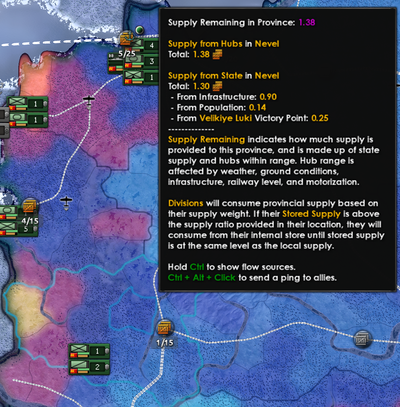
To see how much state supply is available, hover over a province in supply map mode to bring up the province supply tooltip. In this province, we can see there is 0.90 state supply from level 3 infrastructure, 0.14 supply from 831,140 population, and 0.25 from the level 1 victory point in Novgorod.
一個地區擁有勝利點會有0.2的地區補給。然後會有0.05的供應了該地區0.05的勝利點(例如,這個地區有1個1點VP,和1個5VP,會有0.5的補給來自VP,生產0.2的基礎和0.3的來自該地區6VP)其中的一些示例見下表:
| VP
|
50
|
20
|
15
|
10
|
5
|
3
|
1
|
| 補給供應
|
2.70
|
1.20
|
0.95
|
0.70
|
0.45
|
0.35
|
0.25
|
基礎設施提供了每等級提供0.3補給,只要基礎建設未受損(基礎設施值見下表)——如果是受損,然而一定數量的地區補給的減少直到破損被修復。
| 基礎設施等級
|
5
|
4
|
3
|
2
|
1
|
| 補給供應
|
1.50
|
1.20
|
0.90
|
0.60
|
0.30
|
Population adds supply on a diminishing scale from 0.01 supply per province in a state of 30.000 people, to 4.25 supply per province in a state with 23.6 M people. Converted to per 1 million people, the scale slides from 0.3 supply per million sparsely populated states to 0.18 supply per million in very densely populated states (e.g. Chinese states).
State supply is evenly distributed to all the units that are in the state (including air and naval units), before other sources of supply are used. Given this, it’s important to be mindful that while there might be enough state supply to support any units outside of hub range, those units will still have to share that state supply with units drawing supply from hubs or ports.
File:Supply-033.jpg This collection of screen grabs shows a number of units drawing supply from the state of Murmansk at the same point in time. Note that ships drawing from the port still consume state supply, as do aircraft on the airfield. Note that the armoured division within range of the hub is drawing the same amount of state supply as the armoured division outside of the hub’s range.
Understanding state supply is essential to understanding how the supply map mode 「heat map」 works – as unlike hub supply, the shading of each province on the heat map takes into account that total amount of state supply available for the whole state - but once that state supply is used elsewhere in the state, the available state supply for other provinces is reduced accordingly. Checking an area to see whether the heatmap shading is due to mostly hub or state supply will provide a clearer indication of the effective supply in the province if more forces are moved into the state in other provinces. Please see the example provided by the two screenshots below for a bit more detail.
File:Supply-031.jpg This tooltip shows that there is 2.75 supply remining in the province. Look closely, however, and notice that it’s all due to state supply – this if that supply is used up elsewhere, once units have moved into the state there will be a lot less actual supply in that province.
File:Supply-032.jpg If we now move in a sizeable force to protect against the border with Italian Libya, the same province that previously had 2.75 supply available now has very little (0.12), because the supply available in the state has been distributed between all of the divisions in that state, leaving only 32% of the division in that province’s requirements.
爭議地區
如果一個國家的控制權在兩個國家之間相互分裂,國家的供應量將被一分為二。中心、人口和基礎設施元素將根據雙方所擁有的國家省份的比例進行分配,而來自勝利點的國家供應將提供給任何擁有包含這些勝利點的省份。
File:Supply-034.jpg These screen grabs show how state supply (the only source of supply in this example) changes as Italian forces advance across the state of Matrouh. In the first screen grab, we see total state supply in Mersa Matruh is 2.75 (note that level of rounding for state supply is to one decimal place, even though two are displayed), then in the second it shows that after the Italian forces have 2 provinces, they have access to 22% of the state supply from base, infrastructure and population, as they now control 2 of the 9 provinces in the state. In the third screen grab, the Italians now have four provinces and the victory point at Marsa Matruh, giving them 44% (4 as a proportion of the 9 provinces in the state) of the base, infrastructure and population supply, and all of the 0.25 state supply provided by the single VP at Marsa Matruh.
空投補給
File:Supply-036.jpg Air supply is shown under the 「Supply from State」 heading in the province supply tooltip, but like state supply, the amount shown is the total available to the whole of the air region. In this case, air supply missions are providing 7.28 air supply to the whole region.
供應系統的三個支柱中的最後一根是空中供應。空中供應由飛行「空投補給」任務的運輸機提供。與國家供應一樣,通過此提供的供應總量在飛行空中供應任務的任何省份提供(無論是否在運輸機的範圍內)。然而,與國家供應不同的是,空氣供應是最後抽取的,所以單位只有在不能滿足國家和補給中心的全部供應要求時才會利用空中補給。
File:Supply-035.jpg Here we see the 2 TrAD Air Wing, comprised of 40 transport aircraft, assigned to air supply in the Northern Front air region. While the range of the transport aircraft does not cover the whole region, the whole region will still receive access to the air supply from this air wing. However, because the transport aircraft cannot cover the whole region, they do receive a penalty to mission efficiency, which affects how much air supply they can provide (and how much supply they require as well).
File:Supply-037.jpg The screengrabs show a number of different situations for units in the 「Northern Front」 air region. Going from from left to right, in the first a division is in a province with access to some state supply, but no hub supply, and so is 「topped up」 by air supply. In the second, two divisions are fully covered by state and hub supply, and so don’t draw on any air supply. In the third, the province has nowhere near enough state supply (and no hub supply at all), and air supply is essential to these units being decently supplied. In the fourth, we see that the air wing flying the supply mission, that is flying from within the air zone, and drawing hub and state supply to provide the air supply elsewhere in the zone.
對於任何空中任務,任務效率將減少可以提供的供應,和效率可以受到一系列元素的影響,包括天氣,中隊執行任務的供應狀態的時候,和空氣區的大小之間的關係和中隊的範圍。在100%的任務效率下,每架供應充足的運輸機在良好的天氣下飛行,能夠提供0.2 每飛機提供.
File:Supply-038.jpg Here the 2 TrAD air wing finds itself in rainy weather (-10% mission efficiency) and with 15% of its aircraft disrupted, dropping the supplies provided through air supply from 7.28 down to 6.2.
空氣機翼的供應需求是由供應的數量他們能夠提供通過他們的任務效率,所以所有其他平等,運輸機的翼可以覆蓋更大比例的空氣區將提供更多的空氣供應比相同大小的翼使用不同的機場,給它更少的報道。運輸機翼飛行空氣供應任務只能使地圖和補給中心,不能增加他們自身的空氣供應
補給不足的影響
地面單位
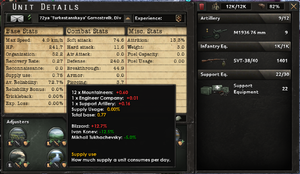
Here we see the supply footprint of the Soviet 72ya Div. Note that the base supply cost (0.77) is a product of its various battalions and support companies, but that it’s been modified up by a blizzard, and down by the supply skills of the army and army group commanders.
一個師為充分供應所需的供應量是基於一系列要素,包括線營、支援營(後勤營減少總供應使用)、天氣及其指揮官的能力。
如果一個師的全部供應不足,一個褪色或鮮紅色的板條箱圖標將出現在其地圖上的圖標上,以及在軍隊的師列表中的圖標上。要精確地查看一個師的供應狀態,請將鼠標懸停在陸軍師列表中的圖標上,以打開工具提示。A部門的供應將轉向在該省可以支持的數額,無論是上升還是下降。,例如,如果一個部門從一個省100%供應去50%供應,第一個小時,新省仍然會有100%供應,然後部門的供應狀態將其存儲供應下降到50%。
File:Supply-039.jpg Here, the 27ya Division is in a poor state, with just 10% supply status (and only 9% stored supply, which will increase to 10% as long as the province supply for the division doesn’t drop).
缺乏一系列單位特性會受到嚴重的懲罰。注意,在達到低供應狀態和全面處罰之間可能會有一個延遲。機組特性受低供應的影響,隨着供應狀態的惡化,影響增加,包括:
- 速度
- 最大組織度
- 組織恢復速度
- 攻擊(防禦單位的最大懲罰(-50%)高於攻擊單位(-20%))
- 突破(針對進攻單位)
- 防禦(用於防禦單位)
- 消耗——如果一個單位的供應水平下降到35%或更少,它將開始採取基本的供應消耗,進一步增加供應的數量來增加該單位使用的設備的數量。
File:Supply-040.jpg The impact of the 27ya Division’s low supply state significantly reduces its movement speed – if it wasn’t for the base game speed of 1km/hr, the speed of the division would be even lower.
File:Supply-042.jpg Here, the somewhat undersupplied British attack the very undersupplied Italians – note the impact on attack and breakthrough/defense of the units on both sides of the combat.
處於低供應狀態也會影響人力增援到達的速度。只要一個師通過友好的省份、港口和/或車隊與首都相連,人力增援部隊就會到達——儘管在非常低的供應水平下,他們可能需要很長時間。然而,注意,設備補給速度不受部門供應狀態的影響(但如果一個部門供應不足,只要是這種情況,他們就會經歷持續的消耗,這可能會阻止部門達到其完整的設備水平)。
如果一個師與首都被切斷,即使是由於占領了一個勝利點或其他國家供應來源,或由於空中補給,它也不會得到人力或設備的增援。
請注意,燃料的工作方式與人力或設備略有不同。和人力和設備一樣,如果被切斷了與首都的補給,它就不會得到補充。和人力一樣,如果一個單元沒有完全供應,燃料補給的速度就會減慢。然而,與人力不同的是,一旦供應狀態足夠差,燃料供應就會完全停止。空中補給不會影響燃料供應,因此即使一個單位可以追蹤一條省份到其首都,並且完全空中補給,如果它沒有足夠的州或樞紐供應,它可能無法得到燃料補給。
File:Supply-041.jpg In the screengrab on the left, the 53rd (Welsh) Infantry Division is at a very low supply status, and it’s going to have to wait nearly a month to be brought back up to strength. In the screengrab on the right, the division has moved into a better-supplied province, and the replenishment is going to happen much sooner.
儲存補給/補給延緩
供應延緩和儲存的供應是指相同的東西,即如果是在一個供應充足的省份,一個部門將儲存的超過100%的供應量。一個師的存儲供應量可以在陸軍UI元素中懸停在一個師的名稱上的工具提示的底部看到,如下例所示。
一個部門可以積累的基本儲存供應量是150%。它下降的速率各不相同,但它應該使一個部門能夠在完全供應效率下運行2-3天,即使它所在的省份沒有完全供應,在儲存的供應下降到100%以下之前。
File:Supply-043.jpg Here the French 25th Infantry Division has accumulated its full amount of stored supply.
對於特種部隊的師,一些技術可以增加補給時間的長度。這可以進一步擴展到海軍陸戰隊師,如果他們是由一個將軍與「兩棲」領導。提供的額外補給延緩是以小時來描述的,但這只是廣泛的指示,因為存儲供應的減少速度可能會根據師所處的情況而不同。
File:Supply-045.jpg Two of the special force technologies can increase supply grace for special forces divisions. The final tech in the tree increases the stored supply in special forces divisions by roughly (it may vary depending on actual conditions) 48 hours.
File:Supply-044.jpg A general with the 「Amphibious」 trait can give marine divisions a very helpful extra 240 hours (more or less, depending on the division’s circumstances) of stored supply. Note that it can take some time to build up to this level of stored supply.
空中單位
一個空軍單位的供應是基於包含空軍基地的省的供應水平。如果一個航空單位正在執行任務,而不是100%供應,由於其供應水平降低,它的效率將出現問題。重要的是要記住,如果供應低於一個閾值,空氣單位也將得不到足夠的燃料,從而進一步降低任務效率。
File:Supply-047.jpg Due to some rather questionable British army deployment orders, the supply to the airbase in South-West England is only sufficient to give 72% supply to the air wing operating from there.
File:Supply-046.jpg Looking at the tooltip for the air unit from the example above, we can see that the impact of being at 72% supply is a 28% penalty on mission efficiency.
海軍單位
對於海軍單位來說,補給不足會直接影響定位效率和維修速度,但也降低了燃料接收率,這取決於燃料情況,也會影響他們在戰鬥中的效率。值得記住的是,值得記住的是,海軍單位可以從他們所抽取的補給中心獲得全部的潛在供應(而不是像陸地和空軍單位那樣受到該省所能支持的限制),因此,海軍單位的供應不足遠不如陸地或空軍單位常見。
File:Supply-048.jpg In these two screengrabs, the situations are identical except that the British (green) fleet on the left-hand side is at 57% supply, and the British fleet on the right hand side is at 76% supply. Note (as highlighted) that the detection chance has increased with the greater level of supply.
盟國補給
默認情況下,你可以從你的盟友的供應中心獲取供應,你的盟友可以從你的供應中心供應。然而,注意,如果你在盟軍領土上作戰,你就不能使用國家供應系統。盟軍師共享土地主人的補給供應,但土地主人的部隊供應可能會更好一些,因為他們也將能夠獲得任何可用的國家供應。
File:Supply-049.jpg Supply-049 – Here, the US task force and the US divisions in Dover draw supply from the British hub, as does the British task force there and a few other British divisions off-screen.
File:Supply-050.jpg On the left, the US divisions in Dover only have access to hub supply, while on the right, the British divisions there have access to both hub supply and state supply, and so are able to maintain a higher supply state.
While the AI won’t do this, if you want allies not to be involved on a particular front, it’s possible to toggle off supply for allies on a hub-by-hub basis. To toggle supply for allies off (or back on) for a particular hub, click on the hub, and then select the blue flag to the left and above the supply hub symbol (see examples below).
File:Supply-051.jpg On the left-hand side, the supply hub is still providing supply to allies. By clicking on the button with the blue flag on it, the situation changes to that on the right, where allies can no longer draw supply from the hub. Notice that there’s a small 「do not enter」 (red circle with a line through it) on the actual supply hub icon as well. Bear in mind that allied supply has to be turned off hub-by-hub – for Britain to completely deny allied supply in Dover, for example, supply needs to be turned off at the hubs in London, Portsmouth and the nearby port to the north.










